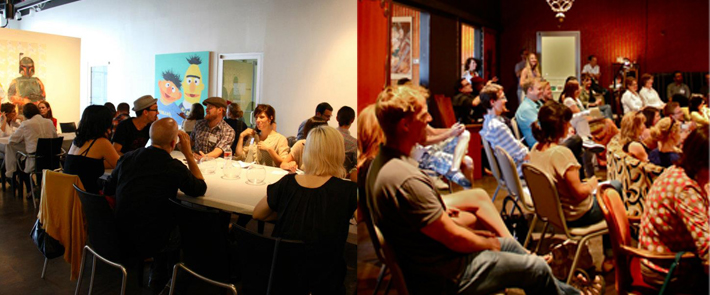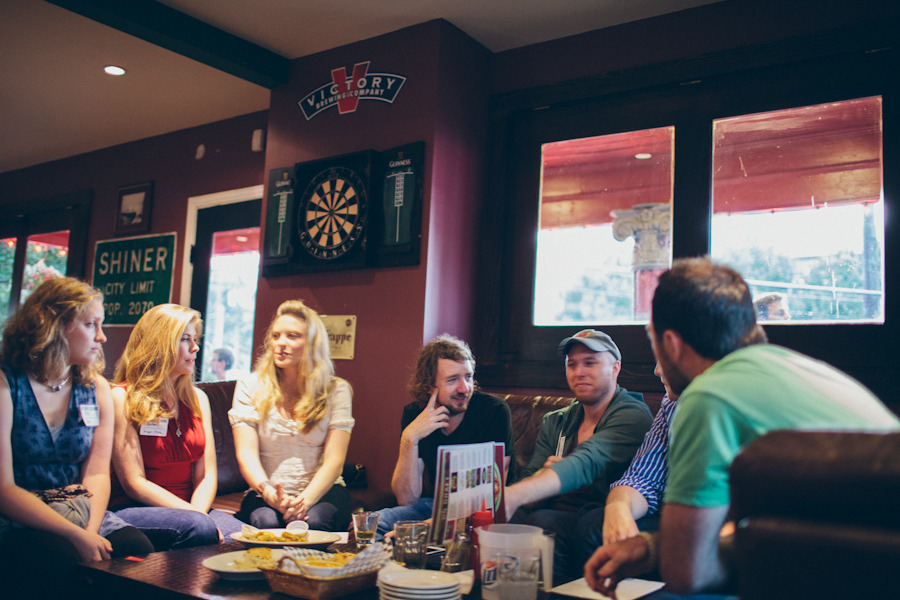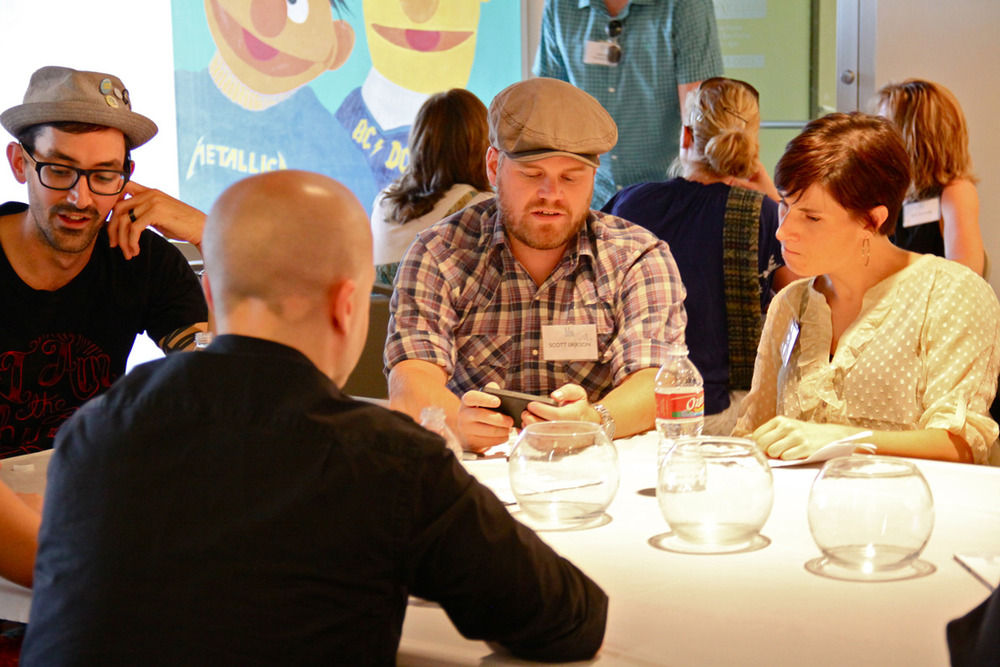Last fall on the morning after Thanksgiving, I took my coffee and journal to the big room. When our house was still a church, this room was the chapel, but for the last two decades it’s been our living room and gathering space. As I walked to my chair, I surveyed the aftermath of our dinner for twenty-seven the day before: the folding tables to be put away, the dishes yet to wash, the dirty tablecloths headed for the laundry, and the table decor of tiny white pumpkins, baby apples and pears, nuts, candles, and English laurel leaves, so carefully arranged on Wednesday and scattered and mussed by Thursday night. The kitchen was fairly clean as everyone had pitched in to help the night before. But the big room is always the last frontier. Oddly enough, I like rising to a quiet house the next morning and seeing some of the feasting evidence still in place. It helps me remember that something significant and life-giving took place in the room just hours before.
That morning as I sipped my coffee I wrote in my journal: I think everyone had a good time yesterday and that makes me happy. I’m compelled to make these gatherings possible without even fully understanding why. It seems we have a human need to observe the traditions of our culture and families, to be included somewhere, to belong. In all the years we’ve been gathering in this house, we’ve had times of coming together with hearts full of sadness and ache for those missing from the table. Death, divorce, and painful relational tensions and mysteries have left their mark. But in the returning faces and the changing faces we’ve also seen redemption. And more often, we’ve enjoyed a simple happiness cultivated through being together around food, beauty, family, and friendship. I like that our children know they can invite those who wouldn’t otherwise have a place to be. And I like that our grandchildren are beginning to collect memories of family, friends, and often strangers, gathered in a large circle of prayer, followed by feasting and talking, with pie and a game of Guesstures after dinner or an egg hunt after the Easter meal. This memory-making is important. I hope that as Chuck and I get older and the work of hosting becomes more difficult, knowing why it matters will help us continue on.
As I age, I understand the power of gathering more clearly. There’s an undercurrent of good being created through the hugs of greeting, the clink of dishes, and the hum of conversation over a meal. I know there are mysteries tied up in these things. But the knowledge has come slowly, one gathering at a time, beginning with our first holiday in a new city.
As Thanksgiving approached in 1989, I was homesick for the loved ones we’d left behind in our move from California to Tennessee that summer. When Chuck, Molly, Sam, and I headed toward Nashville in July, we said goodbye to all that was known and familiar, and by November, I was still in transition.
With Thanksgiving in the air, I felt displaced and in need of comfort. Instead of going to our mother or aunt’s where a feast had always been so faithfully provided for us, we were on our own to figure things out. In California we’d hosted one Easter gathering and a casual Christmas dinner, but we usually made the fifty-mile drive from Sacramento to Yuba City where our families lived. I typically showed up with a side dish or a bag of rolls and stayed on the sidelines while the older women and my father-in-law did all the work. I’d never even helped with a turkey on Thanksgiving, much less cooked one myself.
But moving to Nashville changed all of that. Out of necessity I stepped into the role of “the woman in charge of a holiday.” After multiple calls to my older sister for coaching, I baked some raggedy pies, wrestled the turkey and got it safely in the oven, mashed the potatoes, and carefully followed the steps in a cookbook to make the gravy. We invited a few friends who also brought food, and with their help, successfully pulled off our first holiday in a new city. According to my journal entry on November 26th: We had a blazing fire, played Junior Trivial Pursuit with all the kids, and the grown-ups watched Sherlock Holmes until 1:00 in the morning.
The very next month my best friend Maggie pulled in to town with her family and settled in a neighborhood not far from ours. When I left California, Maggie and I had no idea when we’d ever see each other again, much less live in the same city. We were ecstatic with our good fortune, and beginning with that first Christmas, whenever there was a reason to gather, we did it together. We shared the cooking, invited other California friends who were slowly trickling into Music City along with new folks we were meeting, and began to create for ourselves a new kind of gathering. Everyone brought food, new faces showed up every time, and the loneliness of a new city began to fade.
After a few years in Nashville, we moved our family into the Art House and our gatherings multiplied. Due to its size and personality, the old church was good not only for the community gatherings it was known for, but once we moved in and began renovations, it became the place our family and friends landed most often when it was time to celebrate. The growing experience and pleasure of ceasing routines with no agenda other than the enjoyment of food and relationship hooked me. As time passed, through Cinco de Mayo get-togethers on Maggie’s porch, 4th of July barbeques at my sister-in-law’s, and Sunday night dinners when our kids were leaving the nest, I learned the sweet anticipation and comfort of simply being together.
Now, after so many years in Nashville, my journals and photograph albums are full of the stories of these gatherings. I’ve come to see them as part of the significant work of my life. I have no guarantee they will ultimately have the effect I want them to. But what I suspect, and what I hope, is that the scents, flavors, often-used recipes, family chitchat, friends catching up, and the familiar stamp of the way things are done will seep in, helping to create a family identity and leave a heritage of belonging.
A few weekends ago in April, we celebrated my youngest granddaughter Brinsley’s first birthday with a small party at our house. I baked a Hot Milk Cake for the occasion — a vanilla cake made with milk brought just to the boiling point. It’s a recipe that was handed down by my mother and enjoyed regular rotation in my childhood. My copy is written on the back of a pink receipt for a money order purchased at Feather River State Bank in Yuba City, California, on October 16, 1978. Whenever I make this cake, the date reminds me that I called my mom for the recipe in preparation for Molly’s first birthday. I can see myself, baby on one hip and the phone cradled between my shoulder and ear, scribbling her words down on the nearest piece of paper I could find.
In those days Chuck and I were not doing so well. Our young marriage was hanging by a thread and we lived in a constant state of confusion. However, with our daughter’s birthday on the horizon, we instinctively knew what to do — make a cake and invite the relatives.
On my birthdays growing up, both sets of grandparents were always invited over for cake and ice cream. I have a photograph from my sixth birthday at the house my mom, sister, and I moved in to after my parents’ divorce. I can tell from the ironed tablecloth, the nice dishes filled with scoops of strawberry ice cream, and my cake, that my mom went to some trouble to assure that my birthday would not be overlooked in the midst of her struggles. So when my own daughter’s birthday came along inside the roller coaster of our early marriage, I followed the pattern I knew. We gathered with our collective families and celebrated our little girl’s first year of life, creating a small anchor of goodness in the midst of a turbulent time.
Without the photographs and stories we’ll pass on to our newest granddaughter, Brinsley, she would never remember her first birthday or know the history of the cake recipe I used. She wouldn’t know who came to her party, that her grandpa decorated her high chair with pink streamers, or that her other grandma traveled from Kentucky to be there. But I hope the pictures and stories passed down will help her to know she was always adored, that she belongs in the center of a family who love each other imperfectly but with effort, and that cakes and shared meals are one of the ways we show our love.
More than anything, I want to leave my family with a heritage of belonging, of knowing and being known. I want the power of place, food, people, and God-blessed bonding to nurture our relationships and create memories that travel across time.
In her autobiography, The Long Loneliness, Dorothy Day writes, “We cannot love God unless we love each other, and to love we must know each other. We know Him in the breaking of bread, and we know each other in the breaking of bread. Heaven is a banquet and life is a banquet too, even with a crust, where there is companionship.” This is why we gather. This is how we love.
Andi Ashworth is Editor-in-Chief of the Art House America Blog. She's inspired by cookbooks, gardens in bloom, compassion, kindness, and faithfulness.
Originally posted by Andi Ashworth, May 10, 2012: Why We Gather
To read more from Andi and others in Nashville, visit Art House America's Blog.






























